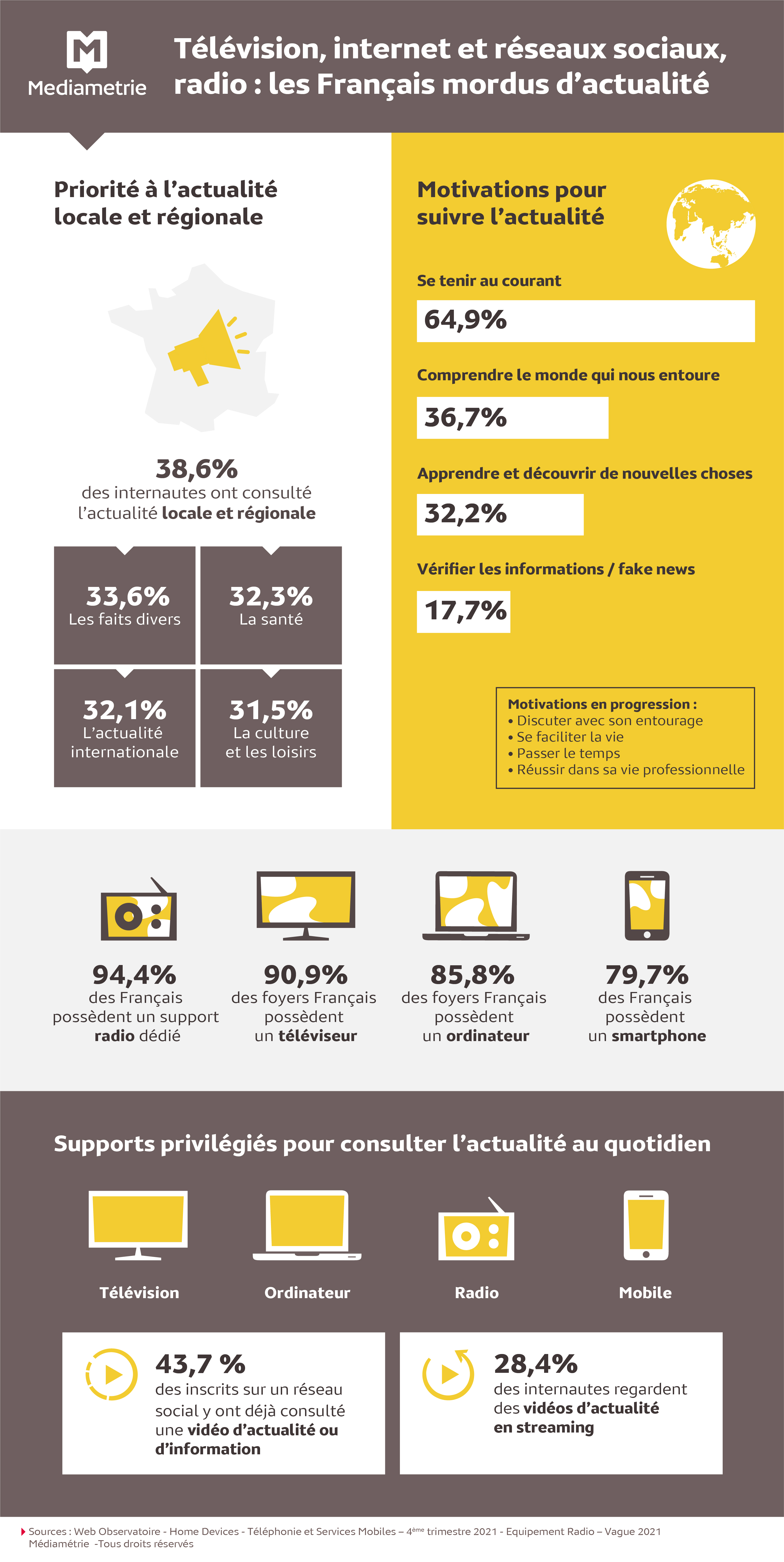- Home
- Results & Studies
- TV, internet and social media, radio: the French are fanatical about news
TV, internet and social media, radio: the French are fanatical about news

Estimated reading time: 2 min 24 s
French people love to follow news stories. In the fourth quarter of 2021, 9 out of 10 French people had checked the news during the previous month. The pandemic, terrorism, US and French elections: has the crowded news landscape of the past two years changed the habits of French people? Which subjects were they most interested in? How is the social media powerhouse manifested in information sources? Médiamétrie detects and deciphers the growing use of digital in France, in particular through its Web Observatory study, and its Current Affairs strand which is analysed in this article.
Local and regional news first
French people following the news were primarily interested in what was happening in their own geographical area. Their focus rested on local and regional news: in the fourth quarter of 2021, nearly 2 out of 5 internet users (38.6%) followed these stories. Next in line were small news items with 1 in 3 Internet users following these (33.6%), ahead of health news (32.3%), international news (32.1%), and lastly arts, culture and leisure (31.5%).
“The French show a keen interest in current affairs, centred on various topics. Most news topics lost some interest compared to the fourth quarter of 2020, with the exception of health stories and small news items which were unchanged," explained Charlotte Leboucher, Research Director at Médiamétrie.
However, news topics of interest differed between age groups, save for small news items which were of interest to everyone. Local and regional news were more closely followed by those aged 35 and over. Young people wanted to be informed about the arts and culture, leisure activities, entertainment and music. Those aged 25 to 49 were more likely to be interested in sports news. Finally, people 65 and over preferred politics and international news.

Keeping abreast of current affairs
Keeping up with the news was primarily driven by the French population's desire to know what was happening in their region, nationally and around the world.
Accordingly, when asked what motivated their interest in current affairs, 2 out of 3 internet users (64.9%) said they wanted to stay up to date. More than 1 in 3 (36.7%) said they kept themselves informed in order to understand the world around them, and almost 1 in 3 (32.2%) were motivated to learn and discover new things.
However, since 2020, these motivations had fallen behind other more concrete reasons, such as being able to talk with family and friends, making life easier, passing the time and career success.
Charlotte Leboucher underlined: “In the booming world of news sources, 17.7% of Internet users keep abreast of current affairs in order to verify information, including fake news."
Television: a safe bet
"Television sets are found in over 9 out of 10 households (90.9%)[1], meaning that it is still the most common device used by news watchers, revealing just how important pictures and live broadcasting remain in the news universe," commented Charlotte Leboucher. Almost 2 out of 3 respondents reported that TV was their preferred media for checking daily news, an increase on the previous year. They also used their mobile phones (1 in 2 people), personal computers and the radio[2]. As a reminder, device ownership is extremely common: radio (94.4% of individuals), smartphones (79.7% of individuals[3]) and computers (85.8% of households1).
TV news was the primary information source with more than 1 in 2 people tuning in daily. Next in line were social media, rolling news channels, search engine news pages, and the radio. Social media had expanded to the extent that 43.7% of registered users of a social network had already viewed a news or informational video.
1 in 2 people spent more than 30 minutes checking the news each day. That figure was down on the last quarter of 2020, when this share stood at 57.1% Young people and those living with children spent less time following the news.
According to Charlotte Leboucher: "Traditional media represent an important forum for following the news, in particular the TV bulletins and morning programmes. Internet users also turn to the Internet to watch news-related content: 28.4% have streamed news videos. That is likely to continue to grow.”
[1]Home Devices – Q4 2021 – Based on Households
[2]Radio Equipment – 2021 Wave – Based on Individuals aged 13+
[3]Telephony & Mobile Services – Q4 2021 – Based on Individuals aged 11+
Laure Osmanian Molinero
des médias
edition
definitions